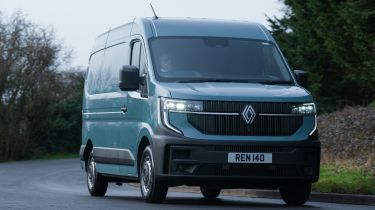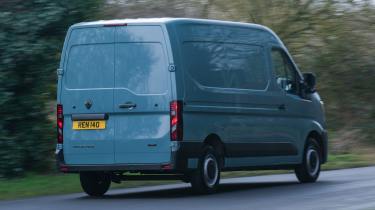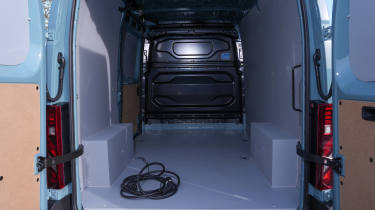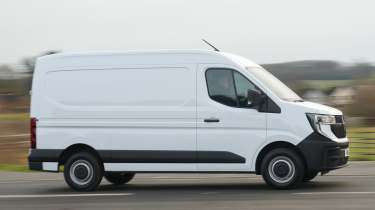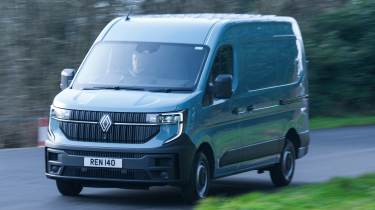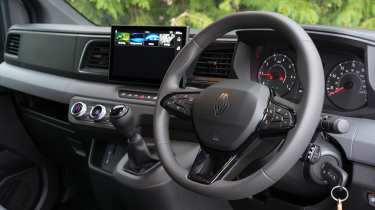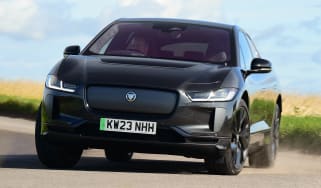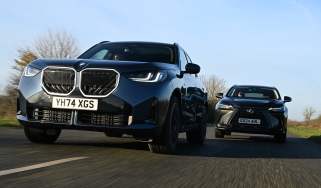Renault Master van review
The latest Renault Master large van is a strong contender in diesel and EV guises
About the Renault Master
For the fourth-generation Renault Master, the French firm has redesigned its large van from the ground up. It looks like an evolution of the last model with a sharper front end, but the dimensions have been changed to maximise cargo space, as well as boost efficiency for both the diesel and electric versions. Renault has seen fit to redesign the Master so that it can maintain sales in the face of strong competition in the market, including the Ford Transit and Mercedes Sprinter, currently Europe’s two best best-selling large vans.
The obvious change to the Mk4 Renault Master is a sharper look up front, with a more upright grille, a prominent Renault badge on the nose and the brand’s signature C-shaped daytime running lights. But what you can’t see is the enhanced aerodynamics of the front end. The bluff front merges into a more upright windscreen, which helps to smooth airflow, while vents cut into either side of the bumper help to reduce drag. At the rear, the roof droops slightly at the trailing edge to help improve aerodynamics, but this doesn’t come at the expense of cargo capacity.
Inside, the cabin changes are significant. The dashboard is entirely new, featuring a slick 10-inch touchscreen with the openR Link infotainment system as found in Renault’s passenger cars. There’s plenty of space for three, while a vast 135 litres of cabin storage is on offer.
More reviews
In the UK there are three lengths and two heights to choose from, plus chassis cab, tipper and conversion options available. Renault claims a total of 40 different configurations are on offer. Power comes from a choice of three diesel engines ranging from 128bhp to 168bhp, plus a full EV, while a hydrogen-powered variant with a zero-emissions range of more than 430 miles is also being developed.
All vans are front-wheel drive, and the least powerful diesel comes with a six-speed manual gearbox as standard. The mid-range version has the option of a nine-speed auto, while this transmission is standard for the most powerful engine. The electric Master E-Tech has 138bhp and is auto only, while the new 87kWh battery offers an impressive claimed range of up to 285 miles.
Cargo volumes range from 10.8 cubic metres in L2H2 form, to 14.8 cubic metres for the L3H3. Importantly, the load area is 100mm longer than in the outgoing model, while the sliding door opens 40mm wider to make it easier to load and unload large items.
As well as taking on the Transit and Sprinter, the Renault Master has a number of other rivals, including the Volkswagen Crafter and MAN TGE, the Iveco Daily, plus the Fiat Ducato, Vauxhall Movano, Peugeot Boxer, Citroen Relay and Toyota Proace Max, which are all closely related, as well as the Nissan Interstar, which is based on the Master.
On the road, a lofty driving position gives you a clear view ahead, while the weighting of the controls, noise levels and ride comfort, helps the Master to be an intuitive and comfortable van to drive, both on the motorway and around town.
Prices kick off at less than £34,000 (+VAT) for the entry-level diesel Master in L2H2 configuration. The Master E-Tech is pricier, costing from around £43,000 (+VAT), but that drops to less than £40,000 with the Government’s low-emission van grant, and means that while the Master has a longer range than large electric van rivals, it costs a few thousand pounds less than its Ford and Mercedes competitors.
MPG, CO2 and running costs
Thanks to a redesigned body, the latest Renault Master has 20 per cent less drag than the old model, and Renault claims that it’s the most aerodynamically efficient van in its class. In the real world, that means improved fuel economy and lower emissions, while the Master E-Tech offers a longer range.
The diesels use a new Blue dCi 2.0-litre four-cylinder engine with three power outputs. The base 130 engine can achieve up to 33.2mpg on the combined cycle, a figure that’s matched by the most powerful 170 engine. The middle-tier 150 engine is slightly better, achieving up to 34mpg. These figures are for Masters equipped with the manual gearbox – we expect fuel economy to drop marginally if the nine-speed automatic is fitted.
Emissions figures are impressive for the class, with a 39g/km reduction when compared with the outgoing Master. Figures range from 196g/km to 236g/km for all engines, with the exact figure depending on specification. There’s an ‘Eco’ mode for maximising fuel economy, but this simply reduces engine power by 30 per cent, and if you’re carrying a heavy payload, then you’re likely to cancel out any savings it might deliver by using the throttle harder, especially with the dCi 130 motor.
The electric Master E-Tech is fitted with an 87kWh battery – up from 57kWh in the last version – and this is good for up to 285 miles of range. This is a smaller pack than some rivals offer, but the aerodynamically efficient bodywork means that range compares favourably, beating the latest E-Transit’s 249-mile maximum, the Citroen e-Relay’s 261-mile range, and the Mercedes eSprinter’s 273-mile range.
During our first test drive, we saw the battery lose 21 per cent of charge over the course of 52 miles with a 400kg payload, suggesting a laden real-world range close to 250 miles. We drove across a mixture of high-speed and urban roads, in 20-degree Centigrade temperatures with the air-conditioning on. You can expect a shorter range in cold coditions. On another occasion and with an unladen van, the Master’s trip computer recorded efficiency of 2.4 miles per kWh, which isn’t bad for such a large, heavy electric van.
The battery can be DC rapid-charged at speeds of up to 130kW, allowing you to add more than 140 miles of range in 30 minutes. AC home charging tops out at 22kW – fast enough for a 10-100 per cent recharge to be completed in around four hours. There’s no heat pump tech to speak of but Renault has implemented a unique battery thermal management system that it claims is more efficient. The battery itself is made up of 12 separate modules that can be removed, repaired or replaced individually, theoretically making it easier and cheaper to fix should something go wrong.
Load space and practicality
There’s a decent range of Renault Master bodystyles to choose from, including panel vans, crew cabs, chassis cabs and several factory-approved conversions. The panel van can be ordered in L2H2, L3H2 or L3H3 configurations, offering 10.8, 13.0 and 14.8 cubic metres of cargo volume respectively. That’s slightly more than in the equivalent Ford Transit, but the Master lags behind the Citroen Relay and Iveco Daily, which offer up to 17.0 and 19.6 cubic metres of load volume respectively.
Currently, the diesel Master is only offered with a 3.5-tonne maximum gross weight, while the Master E-Tech can also be ordered in 4.0-tonne configuration. Maximum payload capacity for the L2H2 diesel Master stands at 1,971kg, beating the 1,472kg of an equivalently-sized Transit.
By using a relatively small 87kWh battery, Renault has managed to keep the weight of the Master E-Tech low. As a result, maximum payload capacities are higher than electric rivals, with the 3.5-tonne Master E-Tech capable of carrying up to 1,125kg, while the 4.0-tonne version manages up to 1,625kg. A 3.5-tonne Mercedes eSprinter can only carry a 774kg payload.
The load area is 100mm longer than before and the sliding door opening is now 40mm wider, increasing those dimensions to 3,225mm (3,855mm for L3 models) and 1,312mm respectively. There was never an issue fitting a Euro pallet through the door of the old Master, so it certainly won’t be a problem here, while a more upright bulkhead means it’s easier to stack boxes against it.
New for the electric Master is ‘vehicle to load’ (V2L) charging, allowing you to power tools and appliances directly from its battery through power socket outlets in the cabin and load area. There’s ‘vehicle to grid’ (V2G) charging, too, which lets you send power back into the network.
Reliability and safety
It’s hard to accurately assess reliability at this point because the Renault Master is brand new. The outgoing model had a fairly spotless record and the new one uses the same engines found in the latest Renault Trafic, which seem to be holding up without issue so far.
The Master comes with a comprehensive suite of safety and assistance systems across all models. There are 20 features in all, with highlights including autonomous emergency braking, driver attention monitoring, intelligent speed assist, traffic sign recognition and lane-keeping assist. Other helpful tech includes the standard-fit rear parking sensors, the trailer stability assistance and the (optional) digital rear-view mirror. We think the latter is worth paying for; it’s clear, bright and has virtually no delay.
Driving and performance
We get three diesel variants of the Renault Master in the UK, along with one electric model - the Master E-Tech. The diesels all use new 2.0-litre Blue dCi engines, with power outputs of 128bhp, 148bhp and 168bhp. The entry-level motor has a six-speed manual gearbox as standard, while the mid-range version can be had with the nine-speed automatic gearbox that comes with the most powerful engine for around £2,000 extra. Heavy-duty Masters are only available with the 148bhp engine and manual gearbox.
On the move, the 148bhp model has plenty of punch down low, despite its peak 360Nm of torque lagging behind an equivalent Transit. We tested it on a variety of roads and had no problem keeping up with traffic around town and on the motorway, with plenty of punch available at lower revs. Only above 3,000rpm does the pulling power begin to drop off, but we think it’s more than enough for most customers. If you’ll be regularly approaching the Master’s load capacity, the 168bhp has marginally more shove, but it’s only really noticeable when overtaking at motorway speeds. Torque stands at 360Nm, so in theory it should be more comfortable hauling heavy loads.
The six-speed manual gearbox is pleasant to use, with a short throw and robust action allowing you to concentrate on steering. Similarly, the clutch pedal is intuitive and well weighted for easy around-town driving. General refinement for the diesels is good, too, thanks to the fabric-finished trim for the cabin’s roof and bulkhead that boosts sound deadening. Engine noise only becomes obvious when you floor it and let the revs rise, while there’s some booming at motorway speeds.
The main issue with the Master is its size. At more than two-metres wide, it’ll be tricky threading this large van down narrow country roads, although rear parking sensors will help position it at low speeds and the tall driving position helps with the view out.
The electric Master E-Tech is even more refined than the diesel, thanks to a silent and smooth motor and the absence of gears – simply move the selector (which is the same column-mounted shifter as you’ll find in a Megane or Scenic E-Tech) into Drive, and away you go, although there is a high-pitched whistle from the electric motor. With only 138bhp and 300Nm of torque, it’s no quicker than the diesels and can’t match the 430Nm E-Transit for acceleration or outright performance, but it feels nippy enough off the line and at speeds up to around 50mph. A regenerative braking mode, labelled ‘B’ on the end of the drive selector, allows for near one-pedal driving and slows the van down with quite some force when you lift off the throttle, but there’s no way to adjust its strength, which is frustrating.
The Master’s brakes are unique in that the power assistance adjusts to compensate for any load in the rear, ensuring that the pedal feels the same no matter the cargo. While we weren’t able to test the Master with different loads, the brakes were strong and predictable at all speeds, with a pedal that felt well matched to the weighting of the accelerator and clutch.
This new generation of Renault Master brings a shorter wheelbase than before, resulting in a tighter turning radius, and we found no problem piloting the Master through narrow French streets. The steering is just as pleasant at faster speeds, with good accuracy that makes it easy to place in its lane along the motorway. Ride quality is a highlight, the Master dealing remarkably well with small and large bumps alike and with a welcome absence of rattles. The standard-fit bulkhead does well to isolate the driver from the load area and prevents any knocks or bangs reverberating through to the cabin.
Safety kit includes intelligent speed limit warning with road sign detection and lane-keep assist, and the Master features the same MyPerso system as found on Renault’s passenger cars. This consists of a button to the right of the steering wheel that can switch between standard and custom modes, with the latter configurable via the touchscreen so you can deactivate the systems that you don’t want. While the Master’s systems default to on every time you start the van, the MyPerso button allows you to quickly configure them with two presses.
Cab and interior
The cab of the new Renault Master feels like a big step forward from the old model. Renault looked to large trucks for inspiration for the new S-shaped dashboard, which improves legroom and angles some of the key controls towards the driver. It’s a far cry from Renault vans of old, feeling much more like a passenger car than a commercial vehicle. There’s plenty of adjustment for both the seat and steering wheel, and visibility is great thanks to a tall driving position and large mirrors that are placed out of the way of the A-pillars.
There are two trim levels to choose from – Advance and Extra – and both come with a crisp 10-inch infotainment touchscreen that runs a Google-based software interface with Apple CarPlay and Android Auto connectivity. It’s simple to operate, very responsive, and within easy reach of the driver’s seat. Plus, the dashboard serves as a handy ledge to rest your hand on when using the touchscreen on the move. The climate control dials are big and sturdy, and sit above a large wireless smartphone charging pad. Electric Renault Masters come with a digital driver’s display, while diesel models are fitted with analogue dials (the digital display is available as an option).
The base Advance model gets manual air-conditioning, electric windows, automatic lights and windscreen wipers plus rear parking sensors among other features, while the Extra trim adds Google Maps and voice control to the infotainment, blue upholstery stitching, LED load area lighting and some additional 12V sockets. There’s no keyless-entry or start and all models have a manual handbrake for now, which seems slightly at odds with the modern electric drivetrain. Van drivers will probably appreciate the old-school approach, however, and there’s no mistaking whether it's on or off. Renault has confirmed that an electronic item is coming in 2025.
You get 135 litres of storage space dotted around the cab, including overhead shelves, some large bins above the dashboard and a big space under the middle seat. Said seat can be folded down to create a handy desk area with USB-C ports to keep devices topped up. There’s one big cup-holder at each side of the dashboard, but the middle passenger has no choice but to hold their coffee.
| Van dimensions | |||
| Body style | Height | Width | Length |
| L2H2 van | 2,502mm | 2,080mm | 5,680mm |
| L3H2 van | 2,502mm | 2,080mm | 6,315mm |
| L3H3 van | 2,780mm | 2,080mm | 6,315mm |
| Load area dimensions | ||||
| Body style | Height | Width | Length | Volume |
| L2H2 van | 1,885mm | 1,537mm | 3,225mm | 10.8m3 |
| L3H2 van | 1,885mm | 1,537mm | 3,855mm | 13.0m3 |
| L3H3 van | 2,138mm | 1,537mm | 3,855mm | 14.8m3 |

